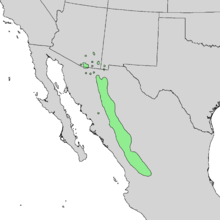Arbutus arizonica
Arbutus arizonica, commonly known as Arizona madrone, is a tree species in the heath family that is native to the southwestern United States and northwestern Mexico. Its range extends along the Sierra Madre Occidental cordillera from the Madrean Sky Islands of southeastern Arizona and southwestern New Mexico[3] south as far as Jalisco. It has been found in Sonora, Chihuahua, Durango, and Sinaloa, with one isolated population in Tamaulipas.[4][5]
| Arizona madrone | |
|---|---|
 | |
| Arbutus arizonica foliage | |
| Scientific classification | |
| Kingdom: | Plantae |
| Clade: | Tracheophytes |
| Clade: | Angiosperms |
| Clade: | Eudicots |
| Clade: | Asterids |
| Order: | Ericales |
| Family: | Ericaceae |
| Genus: | Arbutus |
| Species: | A. arizonica |
| Binomial name | |
| Arbutus arizonica | |
 | |
| Natural range of Arbutus arizonica | |
| Synonyms[2] | |
|
A. xalapensis var. arizonica A.Gray 1886 | |
Arbutus arizonica is a tree that grows up to 45 ft (14 m), and has pinkish-brown bark. The fruit is an orange-red berry.[6] The fruits are edible by humans and used by some indigenous peoples.[7]
References
- Botanic Gardens Conservation International (BGCI) & IUCN SSC Global Tree Specialist Group (2019). "Arbutus arizonica". The IUCN Red List of Threatened Species. IUCN. 208. e.T126504863A148988028. doi:10.2305/IUCN.UK.2019-2.RLTS.T126504863A148988028.en.
- "Arbutus arizonica". Germplasm Resources Information Network (GRIN). Agricultural Research Service (ARS), United States Department of Agriculture (USDA). Retrieved 2012-04-21.
- Biota of North America Program 2014 county distribution map
- Little. Atlas of United States Trees, Volume 3, Minor Western Hardwoods, Little, Elbert L, 1976, US Government Printing Office. Library of Congress No. 79-653298. Map 18, Arbutus arizonica.
- SEINet, Southwestern Biodiversity, Arizona chapter photos, description, distribution map
- Flora of North America, Arbutus arizonica (A. Gray) Sargent, 1891. Arizona madrone
- Laferrière, Joseph E., Charles W. Weber and Edwin A. Kohlhepp. 1991a. Use and nutritional composition of some traditional Mountain Pima plant foods. Journal of Ethnobiology 11(1):93-114.
External links
![]()
![]()
- Lady Bird Johnson Wildflower Center, University of Texas
- photo of herbarium specimen at Missouri Botanical Garden, collected in Arizona in 1881
